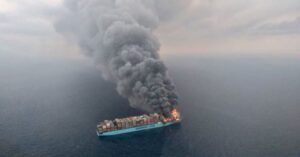The biggest fires on ships ever reported include catastrophic maritime disasters, which resulted in the loss of several lives and had a significant impact on safety regulations.
A few prominent incidents of onboard fires will be discussed in this article.
One such incident was onboard the passenger steamboat General Slocum, which caught fire on June 15, 1904, in New York’s East River, leading to the deaths of over 1000 people. The fire spread swiftly due to flammable materials and poor safety equipment. Several passengers, unable to swim, drowned as they jumped overboard in panic and fear.

This accident led to changes in U.S maritime safety regulations and led to demands for the placement of vessel fire safety inspections under the jurisdiction of the fire departments or other competent authority to ensure accountability.
Congress empowered the Steamboat Inspection Service to decide and enforce fire prevention and extinguishing features and to determine the amount and type of life-saving gear needed on each vessel.
Stricter requirements for the use of fire-resistant materials in ship construction were also implemented. Regular and proper crew training and mandatory fire and emergency drills were also introduced. Vessel safety inspections also became rigorous.

The incident led to amendments in the SOLAS Convention, and regulations were introduced requiring the use of fire-retardant materials in ship construction, replacing wood and lacquered finishes that contributed to the spread of fire.
Automatic fire doors became mandatory for containing fires, and ship-wide fire alarm systems were also made compulsory. They were to be fitted in all public areas onboard the ship, including the cabins, addressing the issue of muffled alarms on the Morro Castle.
The incident inspired the Merchant Marine Act of 1936, which strengthened safety laws and influenced ship design.

Though the investigation identified an arsonist who died in the fire, later findings revealed several fires ignited in different areas, creating doubts about the involvement of more than one person.
The fire began around 2 a.m. on deck 3 and spread to decks 4 and 5. Many crew members were not trained and were not able to communicate effectively with passengers due to language barriers.
Toxic fumes formed, and many died from inhaling excessive smoke and carbon monoxide poisoning rather than burns. The total death toll was 158.

The incident occurred when the ship was 900 nm west of India, en route from Singapore to the Suez Canal.
The Transport Safety Investigation Bureau (TSIB) of Singapore led the investigation. It was believed that the fire started among a block of 54 containers having 1000 tonnes of sodium dichloroisocyanurate dihydrate (SDID), a powerful oxidiser used in disinfectants and pool chemicals.
SDID was classified as IMO Class 9 (miscellaneous dangerous goods) rather than the more stringent Class 5.1 (oxidising substances), despite its hazardous properties when stored in large quantities.

On February 16, 2022, the Panama-flagged car carrier caught fire in the North Atlantic Ocean, about 90 nm southwest of the Azores. The vessel was en route from Emden, Germany, to Davisville, Rhode Island, USA.
The fire started in the cargo hold and engulfed the vessel, with flames seen about 5 m above the waterline.
Luckily, all 22 crew members safely left the ship and were rescued by the Portuguese Navy and local authorities.

